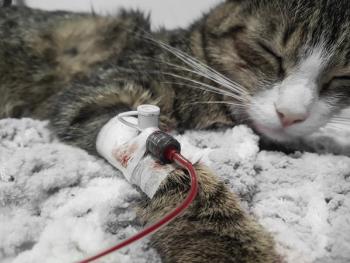
Dermatologic approach to detecting systemic diseases
A look at 3 endocrine diseases in dogs and how the appearance of patients' skin aids in diagnosis
An animal’s skin serves as an important diagnostic tool, according to Caitlin Contreary, DVM, DACVD (Dermatology) with Veterinary Dermatology Center in Maitland and Rockledge, Florida. Thus, her lecture at the 2023 Veterinary Meeting & Expo (VMX) conference in Orlando, Florida, focused on cutaneous manifestations of systemic disease.1 “[The skin] is the largest organ in the body, it's also one of the most easily visible and easily accessible organs. There can be many recognizable markers of underlying systemic disease. And cutaneous symptoms can develop before systemic symptoms in some cases, which can aid in our diagnosis of these internal distances,” she explained.
Three systemic diseases Contreary reviewed that cause hormonal or endocrine disturbances and are associated with cutaneous changes are as follows:
Hypothyroidism
Clinical signs
The noncutaneous clinical signs of hypothyroidism are often weight gain with no diet change, but in addition to these some cutaneous signs may include:
- Symmetrical noninflammatory alopecia with a dry, dull hair coat
- Changes in hair color or texture
- Alopecia in areas of friction or wear (eg, elbows, bridge of nose, trunk)
- Scaling
- Hyperpigmentation
- “Tragic look”
- Recurring pyoderma
- Usually nonpruritic (though may be pruritic if secondary pyoderma is present)
Diagnosis
When diagnosing or attempting to rule out hypothyroidism, Contreary suggested running a full thyroid panel containing a free thyroxine (T4), total T4, and thyroid-stimulating hormone (TSH) test. This helps to better differentiate the condition from euthyroid sick syndrome, as this can also reduce T4 levels. Contreary emphasized that it’s important to look for multiple conditions that may be simultaneously present in a patient with hypothyroidism as well.
Treatment
The treatment for hypothyroidism is using levothyroxine at anywhere from 0.01-0.02 mg/kg, once to twice a day. “I tend to start my dose a bit lower in my older dogs and my dogs with concurrent systemic illnesses, and then go up from there,” Contreary said.
Recheck free T4 as opposed to total T4s at 4 to 6 weeks after you start therapy or after any dose change, she added. It should be tested 4-6 hours after the morning pill of levothyroxine. “It’s important to make sure your clients understand they should still give the [levothyroxine] at the same time every day and fit the appointment time around the time of the medication and not the other way around,” said Contreary. She suggested these pets get rechecked every 6 months.
Cushing’s disease
Clinical signs
Cushing’s disease is caused by excessive endogenous or exogenous glucocorticoids. It can be naturally occurring either from a pituitary or adrenal abnormality, or it can be iatrogenic from administration of systemic or topical glucocorticoids.
Some of the classic noncutaneous signs of Cushing’s disease include polyuria, polydipsia, polyphagia, excessive panting, muscle wasting, pendulous abdomen, and “sway back.”
Meanwhile, the cutaneous clinical signs are:
- Thin, paper-like skin
- Non-inflammatory alopecia and/or failure of hair to regrow
- Prominent, visible blood vessels on ventral abdomen
- Skin bruises easily
- Comedones
- Poor wound healing
- Calcinosis cutis
- Recurring pyoderma
- Usually nonpruritic, unless secondary infections improve pruritus
Diagnosis
Some diagnostic methods include the ACTH stimulation test and/or the low dose dexamethasone suppression test. “I recommend that you do what tests you feel most comfortable with, what you feel you get the best results with or speak with an internist,” advised Contreary. If iatrogenic, diagnosis can be made based on medical history and clinical signs.
Treatment
For pituitary-dependent Cushing’s disease, treat with drugs such as trilostane or mitotane. For adrenal-dependent, removal of adrenal tumor, if possible, can be beneficial. For iatrogenic Cushing’s disease Contreary recommended to stop administration of corticosteroids, however, she recognized, “I know that may not always be possible. For example, I'm using corticosteroids often to treat allergic dermatitis and I have other things available. If you're treating an internal medicine disease, neurologic disease, you may not be able to stop the corticosteroids, but that would be ideal.” It’s important to inform clients that some cutaneous symptoms may not resolve even with treatment, or may resolve slowly.
Calcinosis cutis
Clinical signs
Contreary explained that almost all cases of calcinosis cutis in dogs are deemed to be hyperadrenocorticism. The cutaneous signs include lesions that often start as white to pink papules that progress to thick, gritty-feeling plaques. “When you feel [patients] they almost feel like there's little grits or bits of mineral under their skin because it's calcium deposition in the skin.” The lesions are often seen on the dorsum, but can also be found on the rump, axillae, and inguinal region.
Diagnosis
Definitive diagnosis is based off biopsy and histopathology, but sometimes you can make a diagnosis based on the physical exam if you know the pet has Cushing’s disease.
Treatment
The only way to resolve calcinosis cutis is to resolve hypocortisolemia. You can apply dimethyl sulfoxide (DMSO) gel/liquid once to twice daily to help break down calcium deposits, “but that's not going to fix the problem,” according to Contreary, “It may help, but the only way to do that is to fix the hypercortisolism.” If using DMSO and a large area of the dog is affected, split that area into sections. "I'll alternate treating so we're not necessarily covering a large breed dog with a somewhat smelly DMSO every day," added Contreary. Also, ensure your clients know to wear gloves when handling this solution, and that their pet’s skin may look worse before it starts to improve.
Reference
Contreary C. Cutaneous manifestations of systemic disease. Presented at: Veterinary Meeting & Expo; Orlando, Florida. January 14-18, 2023.
Newsletter
From exam room tips to practice management insights, get trusted veterinary news delivered straight to your inbox—subscribe to dvm360.




